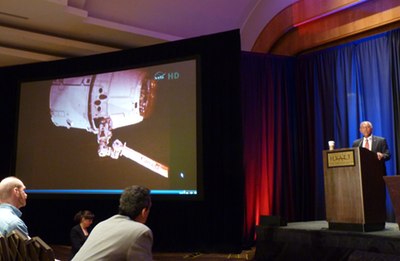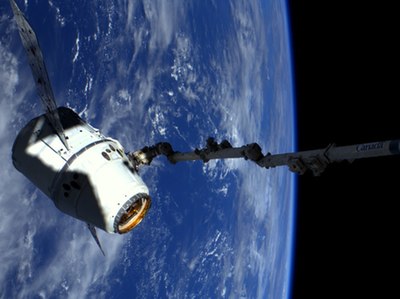A test of technology and a validation of visionby Jeff Foust
|
| “There is so much hope riding on that rocket,” said Musk. “For us it is like winning the Super Bowl.” |
On the next attempt, three days later, there would be no last-second scrub. The Falcon 9 lifted off and placed the Dragon spacecraft into orbit, repeating what it accomplished nearly a year and a half ago on the previous test flight under NASA’s Commercial Orbital Transportation Services (COTS) program. The Dragon, though, soon moved beyond that first flight’s milestones, deploying solar panels and activating other systems needed to approach and rendezvous with the ISS.
Even before arriving at the ISS, SpaceX officials highlighted the early successes of the mission. “There is so much hope riding on that rocket. When it worked, and Dragon worked, and the solar arrays deployed, people saw their handiwork in space operating as it should,” said SpaceX CEO Elon Musk, referring to the SpaceX employees who gathered in the company’s Hawthorne, California, headquarters to watch the launch. “There was tremendous elation. For us it is like winning the Super Bowl.”
Two days after launch, the Dragon approached the ISS, performing a series of maneuvers that brought it to within 2.4 kilometers of the ISS before moving away. Later Thursday NASA and SpaceX announced that Dragon was cleared to approach the ISS on Friday, gradually maneuvering to just ten meters from the station, at which point the ISS’s Canadarm2 would grapple and berth the spacecraft.
That final approach was not without a technical issue, as the Dragon’s LIDAR laser rangefinder system had problems locking onto the station, at one point targeting a retroreflector on another module. After backing up a short distance and reconfiguring the system, Dragon moved in to the capture point. Just before 10 am EDT on Friday, the robotic arm grappled Dragon, pulling it into its berthing location on the station’s Harmony node two hours later.
“Houston, Station, it looks like we've got us a dragon by the tail,” NASA astronaut Don Pettit, at the controls of the robotic arm, quipped when he grappled the spacecraft.
| “Today is, and I’m not overstating this, a day that will go down in history,” Bolden told ISDC attendees. |
If Musk was elated by the launch three days earlier, he was even more ecstatic about the successful berthing. “This has really been the culmination of an enormous amount of work by the SpaceX team in partnership with NASA, and we’re incredibly excited,” Musk said during a post-berthing press conference punctuated by cheers from SpaceX employees. “Really, I don't have words enough to express the level of excitement and elation we feel here at SpaceX for having this work.”
 NASA administrator Charles Bolden (right) answers questions at the ISDC on Friday morning while a screen, displaying NASA TV shows Dragon captured by the space station’s Canadarm2. (credit: J. Foust) |
“An incredibly historic milestone”
At the time Pettit grappled Dragon with the station’s arm, NASA administrator Charles Bolden was giving a previously-scheduled speech at the National Space Society’s International Space Development Conference (ISDC) in Washington. “Private industry’s control of access to low Earth orbit is rapidly becoming a reality,” he said shortly before capture as big screens, displaying NASA TV coverage of the berthing, showed the Dragon approaching ISS. “Today is, and I’m not overstating this, a day that will go down in history.”
About 15 minutes later, as Bolden was fielding questions from the ISDC audience, the capture took place, and he relayed the news to attendees. (Because of a lag in the webcast, the grappling didn’t show up on the screens for a couple of minutes.) “This is an incredibly historic milestone,” he said.
While both NASA and SpaceX emphasized prior to last week’s launch the nature of this mission as a test flight, where things can go wrong, the mission had also been more widely seen as something of a referendum on the model of commercial cargo, and eventually crew, transportation (see “The big test”, The Space Review, May 14, 2012). Advocates were quick to hold up the successful berthing as a demonstration of the broader success of this commercial approach.
“That is exactly what the President had in mind when he laid out a fresh course for NASA to explore new scientific frontiers and take Americans ever deeper into our Solar System while relying on private-sector innovators—working in the competitive free market—to ferry astronauts and cargo to Low Earth Orbit and the International Space Station,” said Office of Science and Technology (OSTP) director John Holdren in a statement Friday, calling the berthing “an achievement of historic scientific and technological significance and a key milepost in President Obama’s vision for America’s continued leadership in space.”
| “The reality remains that SpaceX has spent hundreds of millions of taxpayer dollars to launch a rocket nearly three years later than planned,” said Shelby. “The ‘private’ space race is off to a dilatory start at best, and the commercial space flight market has yet to materialize.” |
Several members of Congress also weighed in, either after Tuesday’s launch or Friday’s berthing. “This is a historic milestone for space exploration and an important achievement for the commercial space industry. We no longer live in a world where space is only explored by government agencies, and we should all take pride that an American company is the first to accomplish this mission,” said Sen. Marco Rubio (R-FL) in a statement Friday.
“Today’s launch is not just a single venture into space but a change in the trajectory of how we think of space exploration,” said Rep. Chaka Fattah (D-PA) in a statement after the launch Tuesday.
SpaceX also got praise from representatives from several space agencies who were in Washington last week for the Global Space Exploration, or GLEX, Conference. “It’s a very important event and can even be a breakthrough in the way we are exploiting the International Space Station,” said Jean-Jacques Dordain, director general of the European Space Agency, in the conference’s opening plenary session just a few hours after Tuesday’s launch.
Not everyone offered unqualified congratulations to SpaceX for their accomplishment. A few in Congress pointed out, subtly or otherwise, that the test flight took place years later than originally planned. When SpaceX won its COTS award in 2006, it said it would perform the three test flights included in the plan “in the late 2008 to 2009 time period,” making this flight—a combination of the second and third test flights in that original award—up to three years behind schedule.
“I was pleased to see the successful launch of the Falcon 9 and the Dragon spacecraft this morning. This launch has been a long time coming, and I am happy to see this very challenging mission begin,” Sen. Key Bailey Hutchison (R-TX) said in a statement after Tuesday’s launch.
While Hutchison may subtly referred to the delays, her colleague, Sen. Richard Shelby (R-AL), was straightforward in his criticism. “The reality remains that SpaceX has spent hundreds of millions of taxpayer dollars to launch a rocket nearly three years later than planned,” he told the Huntsville Times. “The ‘private’ space race is off to a dilatory start at best, and the commercial space flight market has yet to materialize.”
Former NASA administrator Michael Griffin, who started the COTS program shortly after becoming administrator in 2005, offered his congratulations at the GLEX conference Tuesday, but with a different caveat. “In the end, commercial space is not a strategy but a procurement policy,” he said. “Today’s launch was certainly not the fruition of those efforts, but it is certainly a key step along the way.”
| “After today,” Bolden said Friday morning, “I think you’re going to find that there are many more believers [in commercial space] then there were an hour ago.” |
At ISDC—a conference that features a mix of those who work in the industry as well as grassroots space enthusiasts and activists—the mood throughout the event was far more celebratory; less, perhaps, because it was a validation of the current administration’s policy but instead because it marked a realization of long-held beliefs that, some day, private spacecraft would dock with space stations as part of a broader push by civilization into space. “It’s an amazing, amazing day,” said Mark Sirangelo, chairman of Sierra Nevada Space Systems, in a plenary talk Friday immediately after Bolden. “It is the start of the next generation of what we can do in space.”
Sirangelo also shared a Gandhi quote he had provided to Musk after SpaceX’s first Falcon 1 launch failed several years ago: “First they ignore you, then they laugh at you, then they fight you, then you win.” The message the audience took from the quote was that SpaceX, and by extension commercial space efforts, had won on Friday.
In a talk at the ISDC on Sunday, Jim Muncy of PoliSpace likened the public reaction to Dragon to the reaction over a decade ago when Dennis Tito became the first commercial space tourist. “People saw in his flight the possibility of them going,” he recalled. “And likewise, the fact that a private company has done what only governments have done before makes it somehow more normal, somehow more American, somehow more reachable, somehow more relevant.”
“Someone will find something to be critical about” this mission, Bolden predicted in his ISDC remarks on Friday. He reminded them that no shuttle mission, even the most successful ones, were flawless. And this mission is not yet done: on Thursday the ISS crew will unberth the Dragon from the station using the robotic arm. Dragon will depart the station and reenter, splashing down off the California coast—if all goes well, of course.
Whether this mission will be the major milestone for commercial spaceflight that so many described last week is something that only history will be able to answer. Certainly the mission demonstrates a new commercial capability that, in turn, can support the development of additional capabilities, most notably the ability to transport people into orbit, which can enable new markets, expanding the realm of commercial space beyond its current base in satellite launch and operations.
In the near term, though, the flight’s biggest success might be changing the minds of people about the prospects and capabilities of the commercial spaceflight industry. “After today,” Bolden said Friday morning, “I think you’re going to find that there are many more believers then there were an hour ago.”
